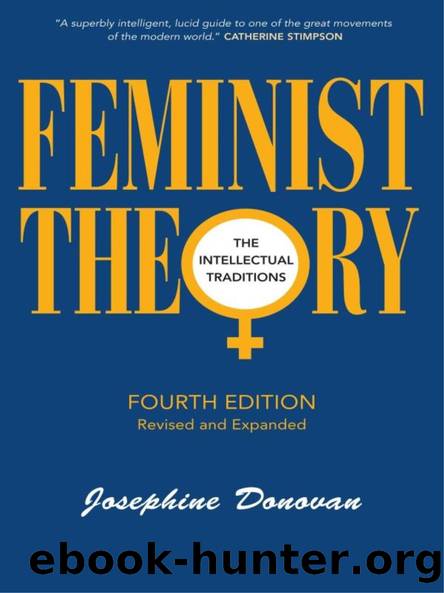Feminist Theory, Fourth Edition by Josephine Donovan

Author:Josephine Donovan [Donovan, Josephine]
Language: eng
Format: epub
Tags: Social Science, Feminism & Feminist Theory
ISBN: 9781441186294
Google: mfSoAwAAQBAJ
Publisher: Bloomsbury Publishing USA
Published: 2012-03-08T03:33:02+00:00
6
Radical Feminism
Feminism must be asserted by women . . . as
the basis of revolutionary social change.
Roxanne Dunbar, 1968
Radical feminist theory was developed by a group of ex-âmovement womenâ in the late 1960s and early 1970s, primarily in New York and Boston. âMovement womenâ were those who had participated in the political activities of the civil rights and antiwar campaigns of the 1960s. Much as nineteenth-century feminists became aware of their own oppression through the treatment they received from their male cohorts in the abolition movement, so twentieth-century radical feminists came to their consciousness in reaction to the contemptuous treatment they received from male radicals in the âNew Left.â That treatment was exemplified at the 1969 antiinauguration demonstration in Washington. When feminists attempted to present their position at the rally, âmen in the audience booed, laughed, catcalled and yelled enlightened remarks like âTake her off the stage and fuck her.ââ1 A description of similar experiences may be found in Marge Piercyâs article, âThe Grand Coolie Damnâ (1969).2
Much of radical feminist theory was therefore forged in reaction against the theories, organizational structures, and personal styles of the male âNew Left.â Having themselves experienced continual âsecond classâ treatment within male radical organizations and because of the machismo radical style, women were concerned that their organizations express internal democracy and allow for an authentic womenâs style (or, at least allow for such a style to emerge). In terms of theory radical feminists became determined to establish that their own personal âsubjectiveâ issues had an importance and legitimacy equal to those great issues being dealt with by the New Leftâissues of social justice and peace. Eventually radical feminists came to believe that all these issues were interrelated, that male supremacy and the subjugation of women was indeed the root and model oppression in society and that feminism had to be the basis for any truly revolutionary change.
Other central theses of radical feminism, developed at the same time and in the same process, included the idea that the personal is political; that patriarchy, or male-dominationânot capitalismâis at the root of womenâs oppression; that women should identify themselves as a subjugated class or caste and put their primary energies in a movement with other women to combat their oppressorsâmen; that men and women are fundamentally different, have different styles and cultures, and that the womenâs mode must be the basis of any future society.3
An early article which articulated many of these ideas was Roxanne Dunbarâs âFemale Liberation as a Basis for Social Revolutionâ (1968). Dunbar urged women not to work in mixed groups like SDS (Students for a Democratic Society), but to form an independent womenâs movement.4 Womenâs grievances, she contends, are not âpetty or personal, but rather constitute a widespread, deeply rooted social disease.â Indeed, all people live âunder an international caste system, at the top of which is the Western white male ruling class, at the very bottom of which is the female of the non-white colonized worldâ (49). Western imperialism is rooted in sexism.
Download
This site does not store any files on its server. We only index and link to content provided by other sites. Please contact the content providers to delete copyright contents if any and email us, we'll remove relevant links or contents immediately.
On the Front Line with the Women Who Fight Back by Stacey Dooley(4311)
The Lonely City by Olivia Laing(4121)
The Rules Do Not Apply by Ariel Levy(3906)
Bluets by Maggie Nelson(3711)
The Confidence Code by Katty Kay(3567)
Three Women by Lisa Taddeo(2920)
Inferior by Angela Saini(2832)
A Woman Makes a Plan by Maye Musk(2831)
Pledged by Alexandra Robbins(2792)
Not a Diet Book by James Smith(2726)
Confessions of a Video Vixen by Karrine Steffans(2675)
Nice Girls Don't Get the Corner Office by Lois P. Frankel(2594)
Wild Words from Wild Women by Stephens Autumn(2589)
Brave by Rose McGowan(2503)
The Girl in the Spider's Web: A Lisbeth Salander novel, continuing Stieg Larsson's Millennium Series by Lagercrantz David(2381)
The Clitoral Truth: The Secret World at Your Fingertips by Rebecca Chalker(2243)
Why I Am Not a Feminist by Jessa Crispin(2240)
Women & Power by Mary Beard(2225)
Women on Top by Nancy Friday(2123)
